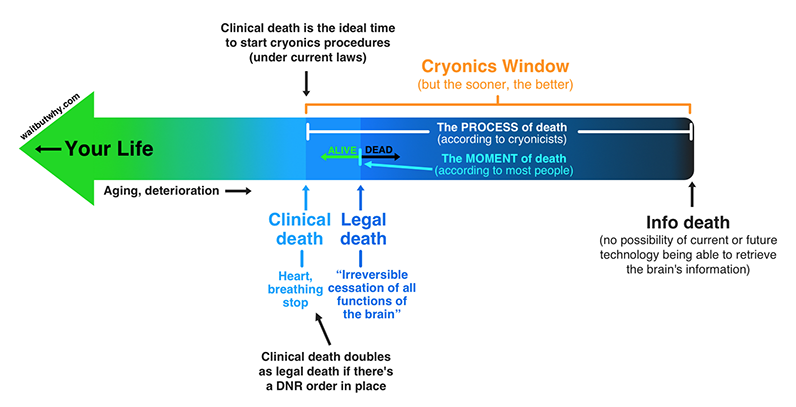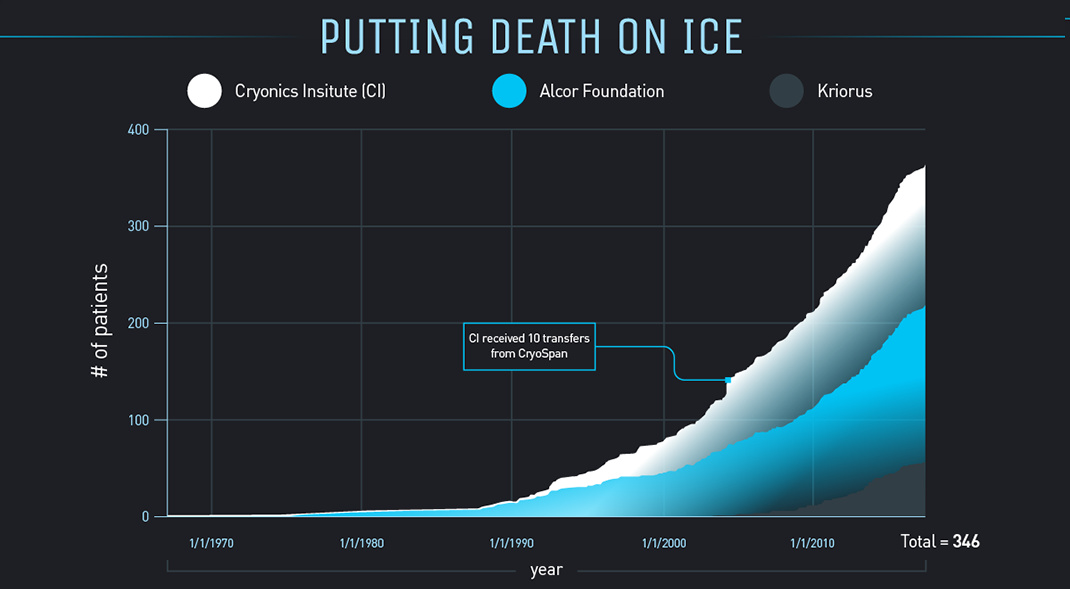Today, the concept is as popular as it’s ever been, and technological advances are giving people hope that immortality, or at very least radical life extension, may be within reach. Is modern technology advanced enough to give people a second chance through cryonics? Today’s infographic, courtesy of Futurism, tackles our growing fascination with putting death on ice.
The Prospect of Immortality
Robert C. W. Ettinger’s seminal work, The Prospect Of Immortality, detailed many of the scientific, moral, and economic implications of cryogenically freezing humans for later reanimation. It was after that book was published in 1962 that the idea of freezing one’s body after death began to take hold. One of the most pressing questions is, even if we’re able to revive a person who has been cryogenically preserved, will the person’s memories and personality remain intact? Ettinger posits that long-term memory is stored in the brain as a long-lasting structural modification. Basically, those memories will remain, even if the brain’s “power is turned off”. Source
Descending into the Deep-Freeze
There are three main steps in the cryogenic process:
- Immediately after a patient dies, the body is cooled with ice packs and transported to the freezing location.
- Next, blood is drained from the patient’s body and replaced with a cryoprotectant (basically the same antifreeze solution used to transport organs destined for transplant).
- Finally, once the body arrives at the cryonic preservation facility, the body is cooled to -196ºC (-320.8ºF) over the course of two weeks. Bodies are generally stored upside-down in a tank of liquid nitrogen.
The Economics of Cryopreservation
At prices ranging from about $30,000 to $200,000, cryopreservation may sound like an option reserved for the wealthy, but many people fund the procedure by naming a cryonics company as the primary benefactor of their life insurance policy. Meanwhile, in the event of a death that doesn’t allow for preservation of the body, the money goes to secondary beneficiaries. Even if we do eventually find a way to reanimate frozen humans, another important consideration is how those people would take care of themselves financially. That’s where a cryonics or personal revival trust comes into play. A twist on a traditional dynastic trust, this arrangement ensures that there are funds to cover costs of the cryopreservation, as well as ensure the grantor would have assets when they’re unthawed. Of course, there are risks involved beyond the slim possibility of reanimation. The legal code in hundreds of years could be vastly different than today. – Kris Knaplund, Law Professor, Pepperdine University
Cold Humans, Hot Market
At last count, there are already 346 people in the deep freeze, with thousands more on the waiting list. As technology improves, those numbers are sure to continue rising. Time will tell whether cryonically preserved people are able to cheat death. In the meantime? The cryonics industry is alive and well. on But fast forward to the end of last week, and SVB was shuttered by regulators after a panic-induced bank run. So, how exactly did this happen? We dig in below.
Road to a Bank Run
SVB and its customers generally thrived during the low interest rate era, but as rates rose, SVB found itself more exposed to risk than a typical bank. Even so, at the end of 2022, the bank’s balance sheet showed no cause for alarm.
As well, the bank was viewed positively in a number of places. Most Wall Street analyst ratings were overwhelmingly positive on the bank’s stock, and Forbes had just added the bank to its Financial All-Stars list. Outward signs of trouble emerged on Wednesday, March 8th, when SVB surprised investors with news that the bank needed to raise more than $2 billion to shore up its balance sheet. The reaction from prominent venture capitalists was not positive, with Coatue Management, Union Square Ventures, and Peter Thiel’s Founders Fund moving to limit exposure to the 40-year-old bank. The influence of these firms is believed to have added fuel to the fire, and a bank run ensued. Also influencing decision making was the fact that SVB had the highest percentage of uninsured domestic deposits of all big banks. These totaled nearly $152 billion, or about 97% of all deposits. By the end of the day, customers had tried to withdraw $42 billion in deposits.
What Triggered the SVB Collapse?
While the collapse of SVB took place over the course of 44 hours, its roots trace back to the early pandemic years. In 2021, U.S. venture capital-backed companies raised a record $330 billion—double the amount seen in 2020. At the time, interest rates were at rock-bottom levels to help buoy the economy. Matt Levine sums up the situation well: “When interest rates are low everywhere, a dollar in 20 years is about as good as a dollar today, so a startup whose business model is “we will lose money for a decade building artificial intelligence, and then rake in lots of money in the far future” sounds pretty good. When interest rates are higher, a dollar today is better than a dollar tomorrow, so investors want cash flows. When interest rates were low for a long time, and suddenly become high, all the money that was rushing to your customers is suddenly cut off.” Source: Pitchbook Why is this important? During this time, SVB received billions of dollars from these venture-backed clients. In one year alone, their deposits increased 100%. They took these funds and invested them in longer-term bonds. As a result, this created a dangerous trap as the company expected rates would remain low. During this time, SVB invested in bonds at the top of the market. As interest rates rose higher and bond prices declined, SVB started taking major losses on their long-term bond holdings.
Losses Fueling a Liquidity Crunch
When SVB reported its fourth quarter results in early 2023, Moody’s Investor Service, a credit rating agency took notice. In early March, it said that SVB was at high risk for a downgrade due to its significant unrealized losses. In response, SVB looked to sell $2 billion of its investments at a loss to help boost liquidity for its struggling balance sheet. Soon, more hedge funds and venture investors realized SVB could be on thin ice. Depositors withdrew funds in droves, spurring a liquidity squeeze and prompting California regulators and the FDIC to step in and shut down the bank.
What Happens Now?
While much of SVB’s activity was focused on the tech sector, the bank’s shocking collapse has rattled a financial sector that is already on edge.
The four biggest U.S. banks lost a combined $52 billion the day before the SVB collapse. On Friday, other banking stocks saw double-digit drops, including Signature Bank (-23%), First Republic (-15%), and Silvergate Capital (-11%).
Source: Morningstar Direct. *Represents March 9 data, trading halted on March 10.
When the dust settles, it’s hard to predict the ripple effects that will emerge from this dramatic event. For investors, the Secretary of the Treasury Janet Yellen announced confidence in the banking system remaining resilient, noting that regulators have the proper tools in response to the issue.
But others have seen trouble brewing as far back as 2020 (or earlier) when commercial banking assets were skyrocketing and banks were buying bonds when rates were low.

















